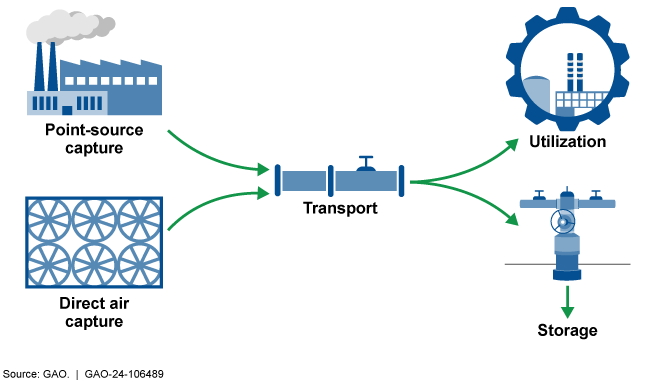Decarbonization: Opportunities Exist to Improve the Department of Energy's Management of Risks to Carbon Capture Projects
Fast Facts
Carbon capture technologies could help the federal government meet its goals to reduce carbon dioxide levels in the atmosphere. From FY 2018-2023, the Department of Energy provided about $1.4 billion to fund 654 research and development projects related to carbon capture, use, and storage or directly extracting CO2 from the air.
However, the DOE office that handled nearly 70% of funding didn't always follow guidance on reducing project risks when selecting and managing projects. This is crucial given the $12 billion DOE will dispense for carbon capture projects in coming years.
We recommended DOE improve how it oversees carbon capture projects.
Components of carbon capture, utilization, and storage and direct air capture

Highlights
What GAO Found
The Department of Energy (DOE) obligated almost $1.4 billion across 654 research and development projects to support carbon capture, utilization, and storage and direct air capture technologies from fiscal years 2018 through 2023. DOE's Office of Fossil Energy and Carbon Management (FECM) administered $950 million (69 percent) of funds and 410 projects (63 percent).
The Department of Energy's Obligations for Carbon Capture Projects by Office and Project Type from Fiscal Years 2018 through 2023

Based on a review of DOE documentation for a nongeneralizable sample of 40 projects, GAO identified several practices, such as risk reviews, that DOE offices used to manage risks. However, FECM—responsible for the majority of projects, including 25 in GAO's sample of 40—engaged in practices as discussed below that could undermine the likelihood of project success:
Risk treatment. FECM did not clearly document risk treatment strategies for some projects—which can be important for project continuity given turnover in project managers. Additionally, FECM did not clearly document that project awardees reviewed project risks and treatment strategies for identified risks on a regular basis.
Project selection. DOE guidance states it should only select projects that are technically acceptable. However, GAO identified one case where FECM selected a $14.6 million project even though its technical score did not meet FECM's threshold. FECM was unable to provide documentation as to why this project was selected. This project, which is ongoing, has since experienced cost overruns and delays, resulting in an additional $5.1 million in FECM funding and an additional 18 months to complete.
It is unclear how widespread these practices are across all 410 FECM projects. However, by documenting risk treatment strategies and adhering to project selection guidance, FECM would provide greater assurances that selected projects are likely to succeed. This could also help reduce the risk to the over $12 billion appropriated for new carbon capture and direct air capture projects.
Why GAO Did This Study
In 2023, carbon dioxide (CO2), the most abundant greenhouse gas, reached a record high concentration in the Earth's atmosphere, according to the National Oceanic and Atmospheric Administration. Scientific assessments have shown that reducing CO2 emissions could help mitigate the negative effects of climate change. The federal government aims to achieve net-zero greenhouse gas emissions, including CO2, by no later than 2050.
Carbon capture and direct air capture technologies have the potential to help the government meet the 2050 goal. The 2021 Infrastructure Investment and Jobs Act appropriated about $12 billion for DOE to administer new carbon capture and direct air capture projects.
Congress included a provision in the USE IT Act for GAO to review federally funded carbon capture and direct air capture projects. This report (1) describes the funds obligated by DOE to support these projects from fiscal years 2018 through 2023 and (2) examines DOE's project selection and management. GAO analyzed laws, regulations, and guidance; DOE funding data; and DOE documents for a sample of 40 projects. GAO selected projects to range in type, funding, and stage. GAO also interviewed DOE officials.
Recommendations
GAO is recommending that FECM (1) more clearly document project risk treatment strategies and (2) ensure that the office adheres to guidance for selecting projects that are deemed to be technically acceptable. DOE agreed with GAO's recommendations.
Recommendations for Executive Action
| Agency Affected | Recommendation | Status |
|---|---|---|
| Department of Energy | The Principal Deputy Assistant Secretary for the Office of Fossil Energy and Carbon Management should take actions to more clearly document project risk treatment strategies consistent with the project management principles identified in its Guide to Financial Assistance. (Recommendation 1) |
DOE agreed with this recommendation. In its August 2024 response letter, FECM stated that it is in the process of updating relevant guidance on risk management for project management staff. As of October 2024, FECM updated its guidance on risk management for project staff and disseminated this guidance to project managers. We will continue to monitor FECM's implementation of this guidance.
|
| Department of Energy | The Principal Deputy Assistant Secretary for the Office of Fossil Energy and Carbon Management should take steps to ensure that the office adheres to guidance and only selects projects that are deemed to be technically acceptable, as required by its Merit Review Guide for Financial Assistance. (Recommendation 2) |
DOE agreed with this recommendation. In its August 2024 response letter, FECM stated that the Principal Deputy Assistant Secretary will direct staff to follow the DOE Merit Review Guide for Financial Assistance, including guidance for reviewing the technical feasibility of projects. As of October 2024, FECM has directed staff to follow the DOE Merit Review Guide for Financial Assistance to ensure selected projects are technically acceptable. We will continue to monitor FECM's implementation of this guidance.
|
